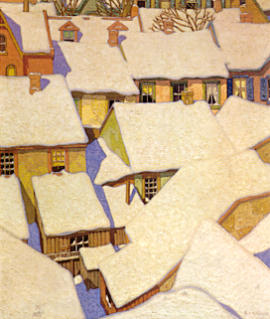I’m off to Maine and Rye! I’m leaving some of my favorite landscape paintings for you—works by Canada’s mighty Group of Seven painters. I love them because they combine the freshness of impressionism with a love for the northern landscape.
 |
| The Edge of the Maple Wood, 1910, AY Jackson |
As a young boy, Jackson worked as an office boy for a lithographer (there’s a trend here) after his father abandoned his six children. It was here that Jackson began his art training.
In his early 20s, Jackson worked his way to back and forth to Europe on a cattle boat, returning to settle in Chicago, where he took classes at the Art Institute. By 1907, he’d saved enough money to go to Paris to study painting.
On his return to Canada, he achieved recognition but no financial success, until The Edge of the Maple Wood was purchased by Lawren Harris. Jackson began corresponding with Harris and JEH MacDonald, which drew Jackson into the Group of Seven orbit.
 |
| Frozen Lake, Early Spring, Algonquin Park, 1914, AY Jackson |
As the most traditionally-trained of the Toronto painters, it’s no surprise that Jackson is in some ways the most conventional among them. But it would be a mistake to dismiss him for that. Jackson evokes the bracing atmosphere of the northern woods like nobody else, and he scrupulously avoids the Art Nouveau stylings that sometimes impinge on Group of Seven paintings. He’s brutally honest about what he sees; the shadow in the foreground of The Edge of the Maple Wood, for example, is not there for compositional reasons.
Join me in October, 2013 at Lakewatch Manor—which is selling out fast—or let me know if you’re interested in painting with me in 2014. Click here for more information on my Maine workshops!




















